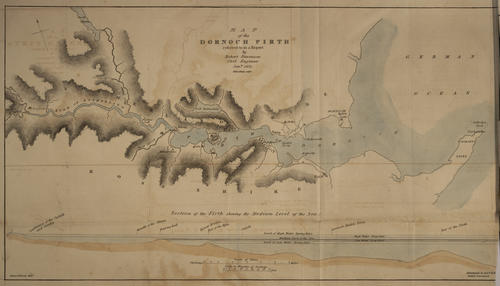
Advocates and law agents usually submitted evidence to the Court of Session in support of a client's claim. Evidence took many forms. Depositions heard by the Lord Ordinary on Oaths and Witnesses (or his designee) became part of the case record. A lawyer might also voluntarily or at the court's behest include a few snippets of correspondence, a ledger extract, or an estate inventory as part of the process. These pieces of evidence were printed in Session Papers as a case moved through the court.
Sometimes lawyers incorporated material extraordinary and in great quantities into the case record. It is not uncommon to find in Session Papers architectural renderings, maps, copious and intimate letters between business partners or family members, ship logs, voter rolls, and other evidence. Some of the original manuscript material survives in the National Records of Scotland; it is entirely possible that other evidence exists in Session Papers only.
The map show here is but one example of the rich evidence Session Papers contain. Civil engineer Robert Stevenson produced a Map of Dornoch Firth as part of a report referenced in the case Murdo Mackenzie of Andross v. Thomas Houston of Creich (1831). In 1830, Mackenzie of Andross filed suit against Houston of Creich over salmon fishing rights in Dornoch Firth. He accused the defender of improperly stretching a fishing net across one of the Firth's lower estuaries. The map, measuring 53 cm x 37 cm, is one of at least three cartographic inclusions in the case record. Their presence makes clear that geographic knowledge was vital to both litigants as they contested access to waterways and the fish within them.
The cases listed below are remarkable for the evidence they contain. From single maps to voluminous letters, the material within these cases can help expand our knowledge of the British Atlantic world.
Related Cases
| Case | Date | Legal Subjects | Abstract |
|---|---|---|---|
| John Steven and Company v. John Douglas | 20 Dec 1774 | Insurance, Deviation | Defender John Douglas provided an insurance policy to pursuer John Steven and Company for a shipment of goods on the Belfast Trader. The planned shipment route was from Belfast to Greenock or Port Glasgow. Before the ship set sail, however, merchants in Stranraer requested that the ship transport some goods from Belfast to Stranraer. The owner of the Belfast Trader agreed to transport these goods. In the course of trying to reach Stranraer, the ship encountered a storm and sank off the coast of Girvan in Ayrshire. Douglas refused to reimburse Steven and Company. Douglas claimed that the voyage taken by the Belfast Trader was different than the voyage provided for in the insurance policy. Steven and Company sought reimbursement, arguing that the voyage to Stranraer on the way to Greenock or Port Glasgow was not a significant deviation from the original route. |
| Murdo Mackenzie of Ardross v. Thomas Houston of Creich | 1831 | Documents available. Full description coming soon. | |
| Hugh Rose v. Macleay's Trustees | 1837 | Case documents digitized and available. Description in progress. |
